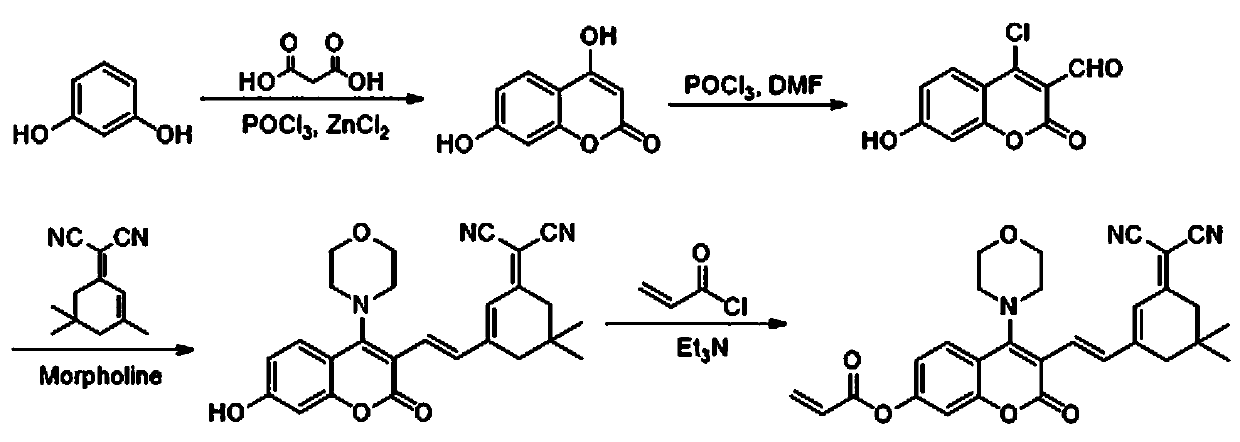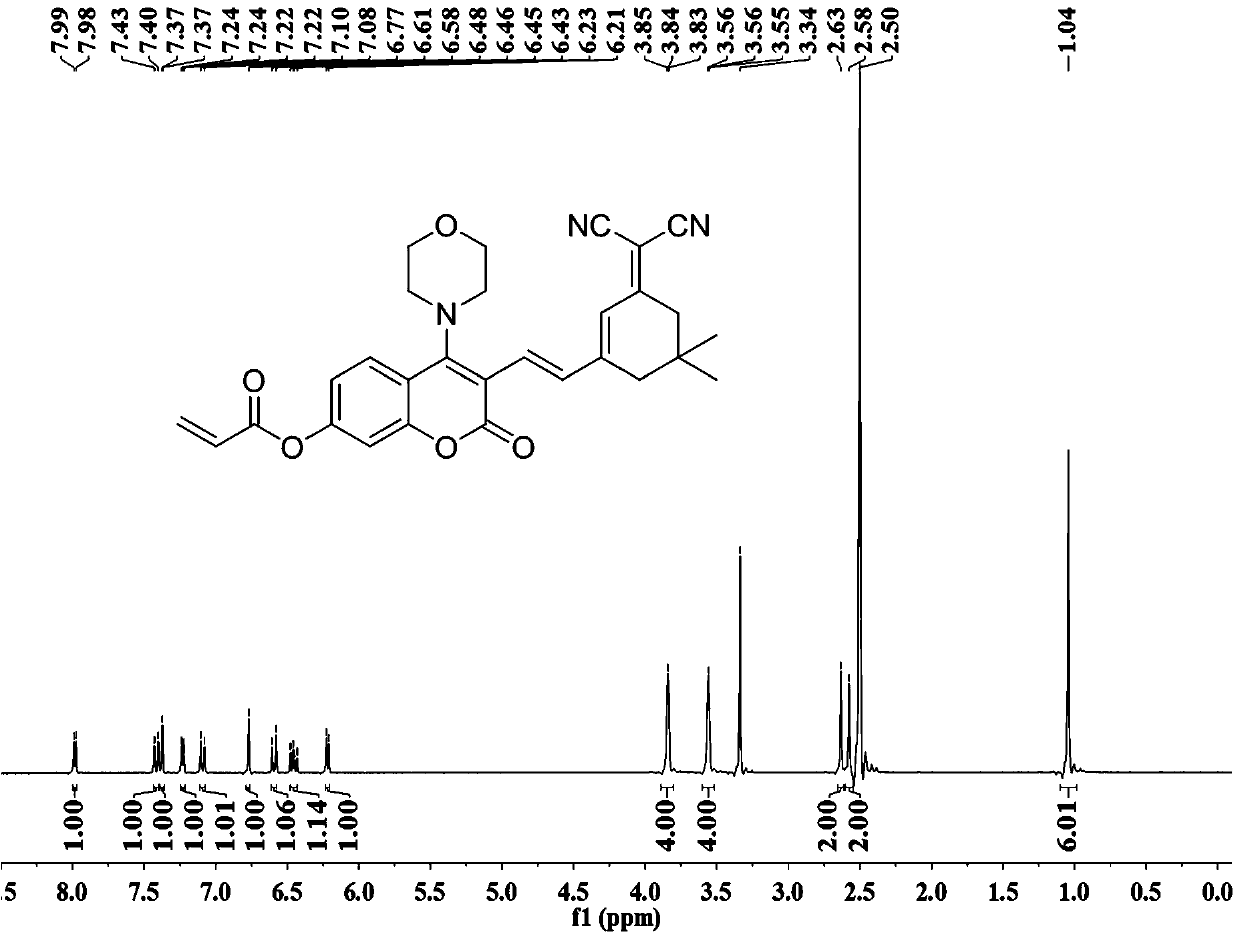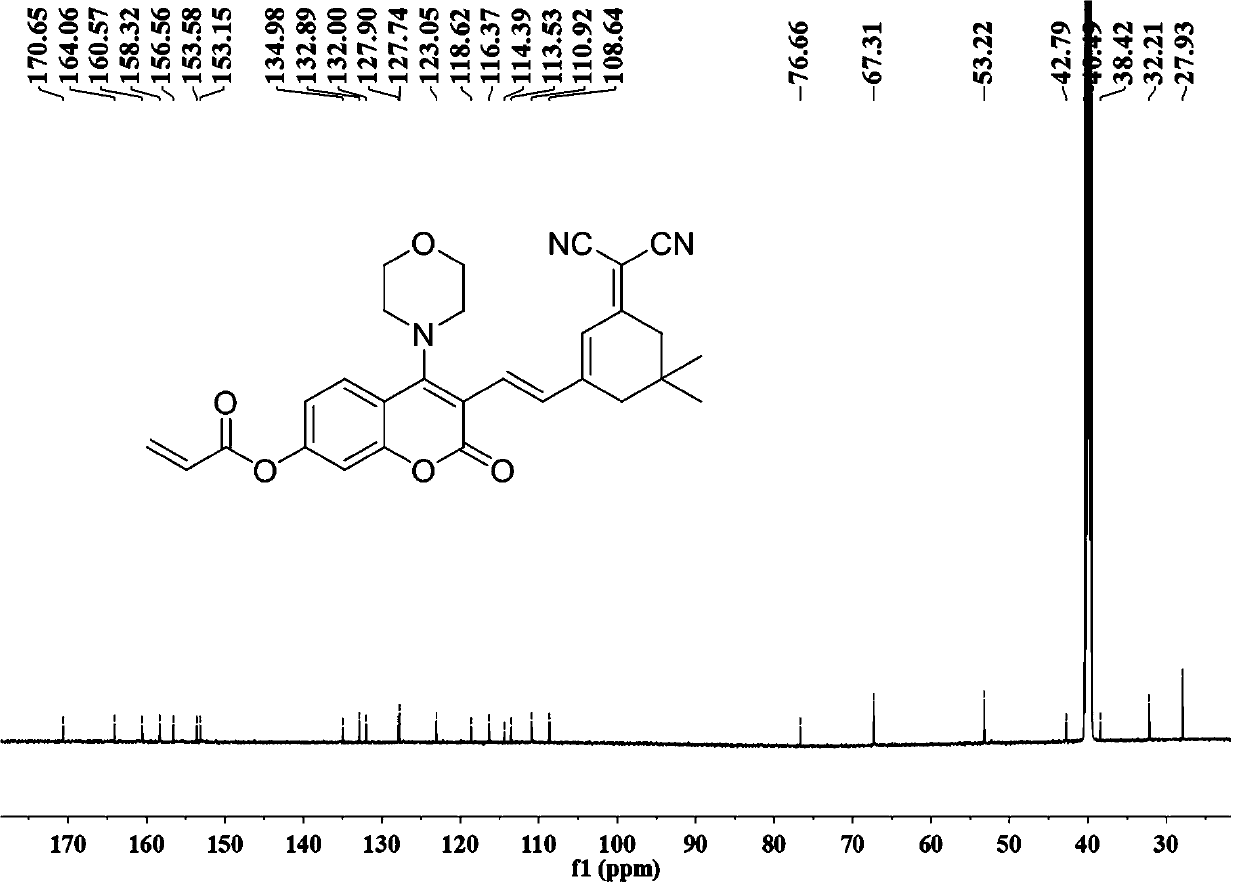Lysosome-targeted Cys near-infrared fluorescent probe and preparation method and application thereof
A fluorescent probe and near-infrared technology, applied in the field of analysis and detection, can solve the problems of detection interference and short emission wavelength, and achieve the effects of fast detection, high sensitivity and novel structure
- Summary
- Abstract
- Description
- Claims
- Application Information
AI Technical Summary
Problems solved by technology
Method used
Image
Examples
Embodiment 1
[0030] Example 1: 3-(2-(3-(dicyanomethylene)-5,5-dimethylcyclohexen-1-yl)vinyl)-4-morpholinocoumarin-7 - the preparation of acrylate, its reaction formula is as figure 1 shown.
[0031] (1) Preparation of 4,7-dihydroxycoumarin: resorcinol (50 mmol, 5.505 g), malonic acid (60 mmol, 6.244 g) and anhydrous zinc chloride (161.5 mmol, 22.009 g ) into 16.5 mL of phosphorus oxychloride, then heated to 60-65 °C and stirred for 12 hours, cooled, added 200 mL of ice water to quench the reaction, filtered, and the obtained solid was dissolved in 5% sodium carbonate aqueous solution, and dilute The pH was adjusted to 3-4 with hydrochloric acid, and a yellow solid was precipitated, which was filtered to obtain 6.95 g of 4,7-dihydroxycoumarin, with a yield of 78%. 1 H NMR (600 MHz, DMSO- d 6 ) δ 12.23 (s, 1H), 10.52 (s, 1H), 7.63 (d, J = 8.6Hz, 1H), 6.76 (dd, J
[0032] = 8.6, 2.3 Hz, 1H), 6.66 (d, J = 2.3 Hz, 1H), 5.38 (s, 1H). The reaction formula is as follows:
[0033] . ...
Embodiment 2
[0041] Embodiment 2: the determination of the fluorescence spectrum of fluorescent probe DCICA and Cys action
[0042] (1) Prepare solution: prepare 2 mM stock solution of fluorescent probe DCICA with dimethyl sulfoxide (DMSO); prepare 2 mM Cys solution with distilled water;
[0043] (2) Add 2 mL of EtOH / PBS buffer solution (v / v = 1 / 1, pH = 7.4) and 10 µL of the fluorescent probe DCICA stock solution into the fluorescence cuvette, and measure the concentration of the probe on a fluorescence spectrophotometer. Fluorescence spectrum (excitation wavelength 510 nm), and then gradually add Cys solution, increase by 5 µL each time, gradually add from 5 µL, and finally add a volume of 50 µL, leave it for 5 minutes after each addition, and record in the fluorescence spectrophotometer The fluorescence spectrum was measured on the surface. After adding Cys, the probe showed a new fluorescence emission peak at 680 nm, and the fluorescence intensity gradually increased with the addition o...
Embodiment 3
[0044] Embodiment 3: the determination of the response time of fluorescent probe DCICA and Cys action
[0045] In the fluorescent cuvette, add 2 mL EtOH / PBS buffer solution (v / v = 1 / 1, pH = 7.4) and 10 µL fluorescent probe DCICA stock solution, then add 5 molar equivalent Cys solution, and measure The fluorescence intensity change of the probe at 680 nm (excitation wavelength 510 nm) was measured on the instrument. As the reaction time prolongs, the fluorescence intensity increases continuously. When the reaction reaches 300 s, the fluorescence intensity is basically constant (see Image 6 ), indicating that the detection method is fast, and the detection can be completed within 5 minutes.
PUM
 Login to View More
Login to View More Abstract
Description
Claims
Application Information
 Login to View More
Login to View More - R&D
- Intellectual Property
- Life Sciences
- Materials
- Tech Scout
- Unparalleled Data Quality
- Higher Quality Content
- 60% Fewer Hallucinations
Browse by: Latest US Patents, China's latest patents, Technical Efficacy Thesaurus, Application Domain, Technology Topic, Popular Technical Reports.
© 2025 PatSnap. All rights reserved.Legal|Privacy policy|Modern Slavery Act Transparency Statement|Sitemap|About US| Contact US: help@patsnap.com



